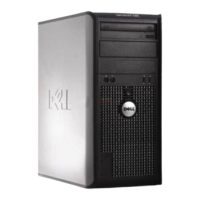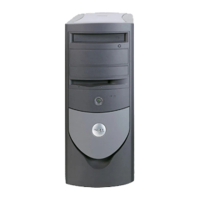304 Glossary
www.dell.com | support.dell.com
BUS — A communication pathway between the
components in your computer.
BUS SPEED — The speed, given in MHz, that indicates
how fast a bus can transfer information.
BYTE — The basic data unit used by your computer. A
byte is usually equal to 8 bits.
C
C — Celsius — A temperature measurement system where
0° is the freezing point and 100° is the boiling point of
water.
CACHE — A special high-speed storage mechanism which
can be either a reserved section of main memory or an
independent high-speed storage device. The cache enhances
the efficiency of many processor operations.
L1 cache — Primary cache stored inside the processor.
L2 cache — Secondary cache which can either be
external to the processor or incorporated into the
processor architecture.
CARNET — An international customs document that
facilitates temporary imports into foreign countries. Also
known as a merchandise passport.
CD — compact disc — An optical form of storage media,
typically used for audio and software programs.
CD
DRIVE — A drive that uses optical technology to read
data from CDs.
CD
PLAYER — The software used to play music CDs.
The CD player displays a window with buttons that you use
to play a CD.
CD-R — CD recordable — A recordable version of a CD.
Data can be recorded only once onto a CD-R. Once
recorded, the data cannot be erased or written over.
CD-RW — CD rewritable — A rewritable version of a
CD. Data can be written to a CD-RW disc, and then erased
and written over (rewritten).
CD-RW
DRIVE — A drive that can read CDs and write
to CD-RW (rewritable CDs) and CD-R (recordable CDs)
discs. You can write to CD-RW discs multiple times, but
you can write to CD-R discs only once.
CD-RW/DVD
DRIVE — A drive, sometimes referred to
as a combo drive, that can read CDs and DVDs and write to
CD-RW (rewritable CDs) and CD-R (recordable CDs)
discs. You can write to CD-RW discs multiple times, but
you can write to CD-R discs only once.
CLOCK SPEED — The speed, given in MHz, that
indicates how fast computer components that are connected
to the system bus operate.
COA — Certificate of Authenticity — The Windows
alpha-numeric code located on a sticker on your computer.
You may need the COA to complete the operating system
setup or reinstallation. Also referred to as the Product Key
or Product ID.
C
ONTROL PANEL — A Windows utility that allows you
to modify operating system and hardware settings, such as
display settings.
CONTROLLER — A chip that controls the transfer of data
between the processor and memory or between the
processor and devices.
CRIMM — continuity rambus in-line memory module —
A special module that has no memory chips and is used to
fill unused RIMM slots.
CURSOR — The marker on a display or screen that shows
where the next keyboard, touch pad, or mouse action will
occur. It often is a blinking solid line, an underline
character, or a small arrow.
D
DDR SDRAM — double-data-rate SDRAM — A type
of SDRAM that doubles the data burst cycle, improving
system performance.
DEVICE — Hardware such as a disk drive, printer, or
keyboard that is installed in or connected to your computer.
DEVICE DRIVER —See driver.
DIN
CONNECTOR — A round, six-pin connector that
conforms to DIN (Deutsche Industrie-Norm) standards; it is
typically used to connect PS/2 keyboard or mouse cable
connectors.
DISK STRIPING — A technique for spreading data over
multiple disk drives. Disk striping can speed up operations

